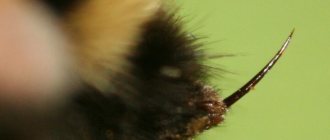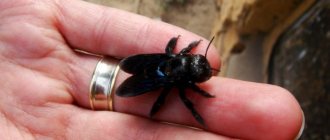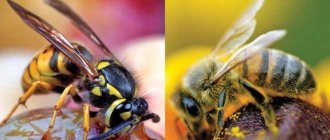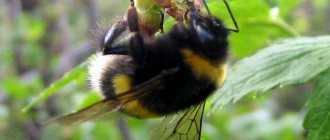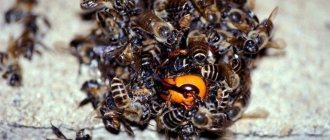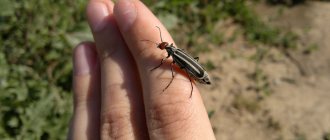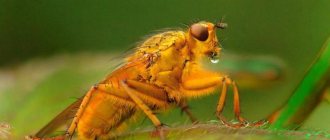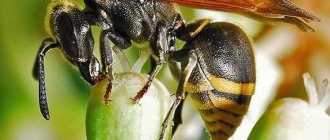Description
Bumblebees belong to the class of arthropod winged insects and are a type of bee. The original name of the genus in Latin is “Bombus”. Creatures are widespread on Earth, living in all corners of the planet where there are suitable living conditions. Now zoologists know about 300 different varieties of insects, which belong to fifty subspecies.
The two most common types of bumblebees are Bombus terrestris and Bombus lapidarius. They live in most countries.
Back view of bumblebee
You can distinguish a bumblebee from other bees by its large size and rounded contours of its body. Thanks to the hairs on their body, they adapt well to cold climates and do not freeze. They are also considered warm-blooded insects. When moving quickly, their body begins to generate heat, and the internal temperature can reach forty degrees.
People have a stereotype that a bumblebee bite is very painful, and in general it is better to beware of insects.
Such fears arose due to the large size of the creature and powerful jaws. However, in fact, this type of bee is the most peaceful and harmless. Interesting fact : the sting of a bumblebee is smooth and does not have serrations, unlike a bee's.
If the latter retains it in the victim, then the bumblebee, having made a bite, can pull it back into the body and fly away. Bumblebees never attack first.
They do not use their jaws as weapons, despite their power, and their only defense is their stinger. But the individual will use it if there is no other way out. Moreover, only females and insects that build a hive have it. Ordinary males do not have a sting and are almost completely defenseless. In nature, the bumblebee brings great benefits by pollinating a large number of flowers.
Bumblebee - description, structure, characteristics. What does a bumblebee look like?
The hero of the article is furry. The bumblebee is covered with hairs, as they say, from head to toe. The cover is thick. The bee's hairs are sparsely planted and are located only on the anterior compartment of the body.
1. Dense and thick compared to a bee’s body. It is also wider than that of a wasp. This is another insect similar to a bumblebee.
2. The presence of stings in females of the species and working bumblebees. However, bee relatives rarely sting. The sting of bumblebees is smooth, like that of wasps. In bees, the process is jagged, so it remains in the human body.
A bumblebee bite leaves behind only painful sensations, local redness, and swelling. Less than 1% of those affected develop an allergy. It is typical for those who have been stung repeatedly.
3. Three-centimeter body length. This is a record compared to wasps, hornets, and bees.
4. Weight about 0.6 grams. This is the mass of working individuals. The uterus can weigh almost a gram.
5. Moderately expressed sexual dimorphism. In particular, the female's head is longer than that of the male and is rounded at the back. The dotted line on the crown is faint. Males have clear stripes and a triangular head.
Males also have longer antennae. Therefore, you can understand whether the photo is a bumblebee or a bumblebee.
6. The proboscis is from 7 to 20 millimeters long. The organ is needed to penetrate the corollas of flowers. Bumblebees extract nectar from them.
7. Striped or completely black coloring. The last case is rare. The coloring is determined by the balance between the functions of protection and thermoregulation. Black, in particular, attracts the energy of the sun.
The frost resistance of bumblebees is due not only to contractions of the chest muscles, but also to the density and length of the fur. It, like a fur coat, warms the insect on frosty mornings and evenings.
In hot weather, the bumblebee's cover, on the contrary, keeps a layer of air near the skin at body temperature, and not at ambient temperature. If an insect needs to cool down, it releases a drop of saliva from its mouth. The liquid evaporates, cooling the animal, which makes the bumblebee's flight easier.
Bumblebees are very large and bright insects, and interestingly, the female bumblebee is larger than the male (which, however, is not such a rarity in the world of insects). Typically, the body length of a female bumblebee is from 13 to 28 mm, a male - from 7 to 24 mm. But some types of bumblebees, such as the steppe bumblebee, can reach large sizes, even up to 35 mm in length. The weight of a bumblebee, if it is a queen, can reach up to 0.85 g, but working individuals will be lighter - from 0.04 to 0.6 g.
An interesting fact - despite their absolute small weight, bumblebees are quite strong insects and can carry a load equal to their own weight.
The body of a bumblebee is thick and heavy, as for an insect, of course. The wings of a bumblebee are small, transparent and consist of two halves that move synchronously. The flapping speed of a bumblebee's wing is 400 beats per second. And the flight speed of a bumblebee can reach 3-4 meters per second.
The female bumblebee's head is somewhat elongated, while the male's is triangular in shape, with a noticeable dotted line on the crown and front part.
The eyes of a bumblebee are located in a straight line, they are not covered with villi. The antennae of males are longer than those of females.
An important organ of bumblebees is a special proboscis, which they use to collect nectar. The length of the proboscis depends on the type of bumblebee and varies from 7 to 19 mm.
There is also a sting in the abdomen of bumblebees, but only in females; the male does not have a sting, and in place of the sting there are dark brown genitals. The sting of a bumblebee is smooth, without serrations and invisible when at rest. So, when bitten, the female bumblebee pulls the sting back and can sting repeatedly, like wasps and hornets, and unlike bees, which die after being bitten.
Bumblebees also have as many as six legs, while the female has a special “basket” for collecting pollen on the outer surface of her hind legs.
The color of the bumblebee is usually striped, black and yellow with white, orange and even red flowers. Sometimes there are completely black bumblebees. Scientists believe that the color of the bumblebee was created for a reason, but is associated with the balance and thermoregulation of the insect’s body.
Appearance and features
Yellow pollen on the black stripes of a bumblebee
A bumblebee has a massive body compared to other bees. Impressive dimensions are achieved due to developed pectoral muscles. They also serve as an additional source of heat along with the fluff. In cool weather, the insect begins to intensively contract its muscles, thereby increasing body temperature. This helps to warm up the body and go to pollinate flowers earlier than other types of bees.
On the sides of the body there are three pairs of limbs: two small legs in front and four large ones coming from the center. Bumblebees fly thanks to two wings located on the front of the body.
Bumblebees are black in color, with two yellow stripes on top: at the head and under the wings. There is also a white stripe in the sting area. The entire body is covered with small hairs, which determine the color pattern.
The head is quite small in relation to the body. At the top there are two long antennae planted next to the eyes. In front there is a powerful jaw, inside of which a long tongue is hidden.
Depending on the type, the insect can be of different sizes. Steppe bumblebees are the largest and can grow up to 3.5 cm in length. In common species, males reach up to 2.5 cm. Females are larger: their length reaches 2.9 cm. The body weight of males does not exceed 0.6 g , but for women it often exceeds 0.8 g.
Why are bumblebees useful?
The bumblebee is an excellent pollinator.
Bumblebees pollinate different plants; they fly from flower to flower faster than bees and pollinate many more plants. They also fly out in cool weather when the bees do not leave the hive.
In areas where the ambient temperature is very low at night, bumblebees buzz very loudly before dawn. But for a long time it was believed that in this way bumblebees get ready for work in the morning and call their comrades to it. In fact, this is how they warm themselves.
Where does the bumblebee live?
Habitat of bumblebees
Due to their good adaptation to environmental conditions, bumblebees live in almost all corners of the planet. Exceptions are places where there is very little vegetation, as well as in hot climates. At high temperatures, the insect begins to feel uncomfortable due to the fact that its body already generates a lot of heat during activities.
In some places the number of bumblebees is small. For example, the Arctic Circle is home to small populations of individual species adapted to cold climates and capable of pollinating local vegetation. In Greenland, Alaska and Chukotka they can only be found in alpine meadows. Small populations also occur in lands with a tropical climate.
Interesting fact : in some countries, gardeners specially breed garden bumblebees to increase productivity.
Most species of bumblebees live in Russia, Europe, Asia and America. They enjoy the local climate and abundant vegetation. Not so long ago, insects were specially brought to Australia, to the state of Tasmania. There they are used to increase the yield of clover, and bumblebees cope with their task with five points. And their peacefulness simplifies the process of using them.
Characteristics
The body is thick, densely covered with long hairs that reduce heat loss. The bumblebee is very muscular. Developed wing muscles make it possible to lift a heavy body with relatively small wings. Flight speed 15 – 17 km/h. Makes 400 wing beats per second.
Species such as the polar and northern bumblebees live far in the north, where summer lasts three to four weeks. They do not lead a family, but a solitary lifestyle. Families of tropical bumblebees, on the contrary, persist for several years. Thanks to its thermoregulation, the bumblebee is able to pollinate plants at low temperatures, which wasps, bees and butterflies cannot. Therefore, it is the main pollinator of the northern regions of Eurasia and America.
Sizes vary. The body length of most species is about 15–20 mm. The world's largest bumblebee, the orange Bombus dahlbomii, native to Argentina and Chile, grows up to 4 cm.
The smallest bumblebee is considered to be the variable bumblebee, living in Central Europe, its length is 1.6 - 1.8 cm. Bumblebees have powerful jaws and a proboscis for sucking nectar. The collected nectar is placed in the goiter. The hind limbs have devices for transporting pollen - brushes and baskets.
Habitat and lifestyle of bumblebees
Bumblebees settle where the plants they are interested in grow.
Since several hundred species of bumblebees live on Earth, each has certain characteristics depending on environmental conditions and habits.
Bombus terrestris lives in Africa. It is black in color with small white spots on its belly. These bumblebees build their hives in the ground; this is done by the workers.
Bombus lapidarius is common in Europe. On its black body there are red-orange stripes, by which it is easy to distinguish it from other representatives of bees. If the African type of insects grows up to three centimeters, then this one is usually no more than two in length. They build their nests on rocks. This species is also characterized by cannibalism: females often feed males to their larvae.
A bumblebee collects pollen and nectar using its proboscis
Regardless of the species, bumblebees live in flocks and have a clear division into roles: queen, males and workers. The queen actively participates in the life of the nest and gives birth to offspring. Males and workers are engaged in approximately the same activities, but the former pay more attention to pollinating flowers, the latter - to expanding and strengthening the house. While bees try to carefully design the nest, planning entrances and internal structure, bumblebees often neglect this. Their houses look shapeless, as if they were made in haste. The material used is fur and wax, which are simply piled up and tunnels are dug inside.
Interesting fact : in order not to build a nest, bumblebees can occupy a mouse hole, driving out the previous occupant.
Bumblebees are very hardworking and go out every day to pollinate flowers. At the beginning of the day, the queen climbs onto the roof of the nest and begins to make loud sounds, thereby awakening all members of the flock from sleep. Having woken up, the insects go to work.
Bumblebee bite and its consequences
As we have already noted, a bumblebee stings rarely and only as a defense. When it bites, it inserts a stinger into a person’s skin, injects poison with it, and extracts it. It can inflict several bites, since its sting does not remain in the human body, but is easily extended. These insects do not sting through clothing. A bumblebee sting is painful and may result in swelling, redness, and itching. Rarely, but it is possible to develop an allergy.
If you are a victim of this insect bite, then you need to take the following steps:
- Take a drug that relieves inflammation and relieves pain, for example, Ibuprofen, Nurofen.
- Apply a cold compress to the bite site.
- Apply a product that relieves itching after insect bites.
- Drink plenty of warm, sweetened liquid.
An allergy develops only in 1% of cases, always after a second bite. The time for the reaction to occur is from a few seconds to half an hour. Depending on the severity of the condition and the threat to health and life, there are 4 stages of allergic reactions.
Important! If the bite occurs on the tongue, inside the mouth, or eyelids, you must urgently seek medical attention. In such cases, the administration of corticosteroids is required.
The most dangerous of them is 4, in which anaphylactic shock and loss of consciousness may develop. All 4 conditions require medical attention and monitoring. They are administered antihistamines and adrenaline. So, bumblebees are large winged insects that collect nectar from flowers, produce honey, and are useful as pollinators in gardening and growing garden plants.
What does a bumblebee eat?
Clover is the favorite delicacy of bumblebees.
Perhaps these creatures are the most finicky of the bee order in terms of food. If wasps can eat jam, honey, tree sap and other sweets, then bumblebees have only pollen and nectar in their diet. However, the list of plants from which they collect food is very long. They pollinate almost all flowers that grow in their habitats. It is often used in gardening. If a beehive has appeared next to the garden, there is no doubt that in the near future there will be a large harvest in the garden beds.
The larvae also need food, so upon returning to the nest, individuals try to bring as much nectar as possible, which serves as food for future offspring. If necessary, the cubs are also fed home-produced honey.
The bumblebee's favorite flower is clover. He is attracted by the smell and color of the plant, and as he flies past he cannot resist. It has also been noticed that bumblebees, just like other bees, are more willing to sit on bright buds than on those that have faded colors. However, if there is no other vegetation nearby, the insect will not hesitate to land on them.
Lifestyle
The bumblebee is a very useful insect, as it pollinates those plants that bees are not able to pollinate. This is the only species that is able to pollinate clover, so without bumblebees you should not count on getting a harvest. These insects form nests both underground and on the surface of the earth.
Interesting fact! Often, especially in the morning, you can hear buzzing coming from their nests. For a long time it was believed that insects ventilate the nest in this way. In fact, as it turned out later, this is nothing more than a kind of exercise before departure. By moving their wings they warm up, and their body temperature rises by several tens of degrees.
The bumblebee, like the bee, is considered a social insect, since there is a distribution of responsibilities in its family. The family consists of a queen, working females and males. Working individuals form housing and collect honey, the quality of which is noticeably lower compared to bee honey. At the same time, the volumes of collected honey are also insignificant.
The duties of the uterus include the constant renewal of the family. She also feeds the first larvae that emerge from the eggs, and the subsequent offspring are fed by the workers. The larvae's diet consists of a mixture of honey and pollen. Males leave the nest forever after fertilizing the queen.
Interesting fact! If there is no queen in the family, then working females can lay eggs.
The lifespan of bumblebees is limited to one season, with the exception of the queen, which hibernates. At the same time, there are species living in the tropics that breed all year round, but they also live no more than a year.
This is interesting! The species inhabiting the Amazon River basin is capable of living for several years.
Every gardener should know that bumblebees are extremely beneficial insects.
Character traits
Bumblebees are friendly and peaceful animals.
Bumblebees live in small flocks. Often the total number of individuals does not exceed hundreds. They are divided into large queens, responsible for the production of offspring, into males, and into small worker insects. Despite the developed social structure, the individual is not attached to the nest and at a certain moment may not return to it and find a new home, joining another flock. Moreover, this is mainly done by males who have already helped females with the production of offspring.
Interesting: The longest river in the world is the Amazon. Interesting facts, description, photos and videos
Bumblebees have a calm character, they do not conflict, they prefer to use their sting only in extreme cases. Perhaps their peacefulness is due to the fact that they are in no way dependent on other living beings, so there is no point for them to enter into confrontation with anyone. The only thing bumblebees need is enough flowers to pollinate. Traveling through the meadows, they carry seeds on their paws, contributing to the emergence of new vegetation.
Sex differences
The female's head has a slightly elongated shape and is somewhat rounded at the back of the head. As for males, their heads are almost round or triangular. In addition, in males you can see a dotted line that runs along the front and crown. Females also differ in that their upper lip is rectangular in shape and has strongly curved mandibles that overlap when closed. Males have quite powerful mouthparts that allow them to gnaw through the stems of blades of grass.
In females, regardless of the species, the sixth sternite is without characteristic ridges, and in males there is no median eminence on the second sternite. The abdomen of females always ends with a multiple action sting. This means that it does not have the characteristic barbs like a bee, and the female can easily pull it out of the victim’s body after a sting. As for the males, they do not have a stinger, which means that males do not bite. Instead of a sting, males have genitals in this place, well covered with a chitinous layer of a dark brown hue.
Males do not have baskets on their hind legs that serve to collect pollen, but they have maximum pubescence, the degree of which depends on the type of insect.
It is important to know! Female insects are divided into 2 categories: workers, who are busy collecting pollen, or queens, who are busy reproducing the family.
Social structure and reproduction
Bumblebee larvae
Like most bees, bumblebees have a clearly formed social structure. The insect lives in flocks, led by queens. At the beginning of spring they go in search of a male to produce offspring. After leaving the male, the female actively feeds so that the eggs are formed correctly.
After several weeks of abundant food intake, she begins to build a nest. Having done a lot of work, the queen settles in a new home, where she lays eggs. Usually there are around 15 of them at a time. They are oval in shape and no more than 4 mm. The larvae hatch on the seventh day after laying. For 20 days, the cubs eat pollen, after which they curl up into a cocoon. And after two and a half weeks, bumblebees are born. The hatched workers begin to engage in construction, and the queens continue to produce offspring.
Interesting fact : if there are not enough females in the flock to quickly increase the population size, they begin to be replaced by working individuals who are also capable of laying eggs.
This is how bumblebees live all year round, until frost sets in. The queens give birth to new offspring. Moreover, workers most often take care of the latter: they bring pollen to the larvae and protect them. The female is only required to lay eggs whenever possible.
How do bumblebees reproduce?
Bumblebee reproduction has four stages:
- Egg.
- Larva.
- Doll.
- Imago (aka adult).
With the beginning of spring, the queen, which has overwintered and is fertilized in the fall, flies out of her shelter and within several weeks is actively preparing for nesting. Having found a suitable place for the nest, the queen begins construction. In a newly built nest, the queen lays 8-16 eggs, which have an elongated shape.
After 3-6 days, bumblebee larvae appear, they grow quickly, feeding on food brought by the female.
After 10-19 days, bumblebee larvae begin to weave a cocoon and pupate. After another 10-18 days, young bumblebees begin to emerge from the cocoons, gnawing at them. By the way, later empty cocoons can be used to store honey or pollen. After the appearance of the first offspring, 20-30 days after the eggs were laid, the queen almost never leaves the nest. The responsibilities for obtaining food are taken over by its first children - working individuals who also perform all other important functions.
As for born males, 3-5 days after formation into an adult, they leave their parental nests in search of other nests and other queens, with whom they will mate in the fall, during the mating season of bumblebees.
Natural enemies of bumblebees
Ants are the main enemies of bumblebees.
Despite their friendliness, the bumblebee has many enemies. The main one is considered to be the ant. Since bees build their nests on the ground, these insects regularly visit them, steal the larvae and destroy the house, tearing it to pieces. Ants are also attracted to honey, which they can eat. Bumblebees try to defend themselves, but since their flock is small and most individuals go out to collect nectar during the day, defense is often ineffective.
Birds, animals and other insects can cause trouble. For example, foxes, hedgehogs and dogs find hives and eat the larvae. Conopid flies see bumblebees as a reliable incubator for future offspring. The female catches up with the bee representative and lays a larva in it right in the air. The latter grows inside, feeds on the organs, and when finally ripe, crawls out.
Among related species, bumblebees can conflict with wasps. There are certain species that raid to eat honey, while others raid to eat the offspring.
Types of bumblebees
There are approximately 300 species of bumblebees living on Earth, which have certain characteristics. Some of them are common in many countries, while others are found only in a small area.
Common bumblebee
The common bumblebee
lives in the European region of the Russian Federation, as well as in western Europe. Despite the fact that it is quite common and is the most famous species, it is listed in the Red Book. Its size reaches one and a half centimeters, and its appearance is familiar to every gardener: a black body with yellow stripes and a white spot at the end.
garden bumblebee
The garden bumblebee
has a light color with black stripes on top and a dark belly. A long proboscis is hidden inside the jaw, which helps in pollinating flowers. Individuals are usually larger than those of other species: the queen can reach 2.5 cm. Garden bumblebees are used in dacha farming because thanks to them, plants bloom much better. The insect is found in Europe, Iceland, Zealand, Transcaucasia and the Urals.
Forest bumblebee
Forest bumblebee
Prefers to settle among trees and pollinate fruit and berry plants. Loves warm climates, builds nests from wood chips and dried grass. It also does not hesitate to occupy rodent burrows. Externally it differs from other species: it is small in size and faded in color with a grayish tint.
Armenian bumblebee
The Armenian bumblebee
prefers to pollinate leguminous plants, promoting their spread. It is found in Ukraine, Russia, Europe, Asia, Iran and the Caucasus. Everywhere the insect population is small, which is why it is considered quite rare. Individuals grow up to 2-3 cm in length, have bright yellow stripes on the back and brown wings.
Earth bumblebee
Ground bumblebee
One of the most useful species for humans. The ground bumblebee specializes in pollinating vegetables and berries, which is why it is often bred artificially. Individuals collect pollen on their bodies, after which they transfer it to other fruits, facilitating their distribution. Insects pay special attention to peppers, tomatoes, blueberries, cucumbers, and strawberries. Externally they are distinguished by their light color: black stripes alternate with bright orange. The species lives in Europe, Asia, Russia and other countries.
Origin of the species
The first species of bumblebees appeared millions of years ago
Scientists believe that bumblebees appeared approximately 30 million years ago, during the Oligocene period. But the found remains of insects from that time are poorly preserved, and the data obtained during the study is not enough to prove their belonging to this species.
Interesting fact : Most insects of the past are studied based on species found in tree resin. But bumblebees, due to their large size, do not fit in a drop of sticky substance, so finding their fossils is a great success.
The oldest insect remains that are definitely bumblebees date back to the Miocene and are approximately 20 million years old. It is believed that this species of bees originated in Asia, from where it gradually moved to Europe. After some time he reached America.
Over the past two centuries, a dozen remains of bumblebees have been discovered, which are from 10 to 20 million years old. Moreover, discoveries were made all over the world, on different continents.
Population and species status
Now the bumblebee population is not in danger.
Bumblebees live on all continents of the planet except Antarctica. Their numbers are quite large, and the species is not in danger. Moreover, since these insects play an important role in nature and gardening, people often breed them themselves. Despite the presence of some enemies from animals and insects, bumblebees quickly compensate for any losses at the expense of fertile queens.
Yes, there are some subspecies of bumblebee on Earth, the population sizes of which are small, but even they are not on the verge of extinction.
Do bumblebees make honey?
Honeycombs in a bumblebee hive
Just like bees, bumblebees make honey, only it has slightly different properties. The product of this insect is more liquid and has a light color. It is also not as sweet as bees. But it contains twice as many vitamins and nutrients.
Bumblebees store honey in oval combs that look like barrels. However, after a few days the liquid begins to ferment if the ambient temperature is more than three degrees.
Bumblebee families
Everyone knows what a bumblebee looks like, but few know how and where it lives. Bumblebees, like bees, live in families, although in one family there are much fewer bumblebees - up to 100. Bumblebees' nests can be located above the ground (in a hollow or even an empty birdhouse), on the ground (in soft hummocks, trunks of fallen trees) or underground.
In bumblebee families, a clear hierarchy is observed. The nest contains several large birthing females, several large fertilizing males, and many small worker bumblebees. The workers build the nest, forage for food, and feed the “children.” After fertilization, large males usually fly out of the nest.
After wintering, some young bees also fly away from the nest in order to organize their own families.
Interestingly, if the queen dies, one of the working females takes over her functions.
Some bumblebees do not create families and do not build nests, but lay their eggs in other people's homes.
Breeding bumblebees at home
Parcel with bumblebees
Bumblebees are very useful in gardening, so many summer residents decide to start breeding them. As a rule, about 50 individuals from one family move into a pre-prepared nest. This ensures that they get along well with each other, distribute roles and begin pollinating plants.
If settlement is successful, the queen quickly begins to produce new offspring, and the workers begin to establish the economy. Before the onset of cold weather, the owner needs to thoroughly fatten the female so that she survives the winter.
Interesting facts about the bumblebee
Incredibly, just one field bumblebee visits more than 2,600 flowers during a 100-minute flight! But this is far from the most surprising fact associated with insects.
- Bumblebees can reach speeds of up to 18 km/h. This is quite an impressive indicator for a Hymenoptera.
- The fur that covers the bumblebee's body is designed to reduce the insect's heat loss by half.
- During the flight period, 90% of the bumblebee's energy is converted into heat. Therefore, a flying bumblebee has a body temperature close to normal human body temperature.
- A bumblebee family is called a colony. The number of colonies can differ sharply: one contains 50 bumblebees, while another contains about two hundred.
- The female insect lays from 200 to 400 “worker” eggs - from which worker individuals are born. And immediately after this it begins laying eggs for the reproduction of queens and males.
- The cuckoo bumblebee is a well-known pest that can mimic the color of any beneficial species of its fellows in order to lay its own eggs in the hive.
- Bumblebees do not pollinate, but after collecting nectar, pollen residues can cling to the abdomen of the insect and thus move to another flower.
After the larva leaves the wax cell of the hive, this niche begins to be used exclusively for storing nectar. The same cell is never used repeatedly to raise offspring.
Author: Alena Yemets
Aerodynamic characteristics
Bumblebee in flight
For a long time it was believed that bumblebees could fly, contrary to the laws of physics. Indeed, a massive body carried on one pair of small wings is quite an unusual sight. However, physicist Jane Wang from a US university was able to prove that there is nothing surprising in the flight of a bumblebee.
The scientist spent several hours simulating the passage of dense wind currents through the moving wings of an insect and found that this process fully complies with the laws of physics.
Bumblebee protection
Most species of bumblebees do not need protection
Since there are several hundred species of bumblebees on the planet, it is not surprising that some of them are on the verge of extinction and are listed in the Red Book. There are several reasons for the population decline: deteriorating environmental conditions, lack of sufficient food, enemies who have settled nearby, etc.
Interesting fact : some species of bumblebees are gradually disappearing because the types of plants suitable for them have disappeared in their habitats, and they fundamentally do not want to switch to others.
At the moment, people are not taking any measures to protect bumblebees. This is due to the fact that, along with endangered species, there are also those that, on the contrary, are increasing their populations. Due to them, the bumblebee family as a whole does not die out, which is the main argument not to take any measures.
